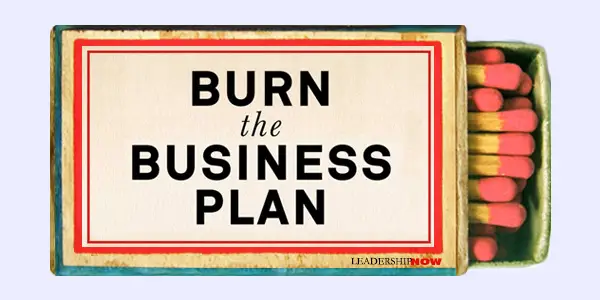 |
 |
05.18.18

Burn the Business Plan
I The highly-romanticized, high-tech startups that we read about and want to emulate are less than seven percent of all start-ups and they experience the highest failure rate of all business startups. Eighty percent disappear within five years. Most entrepreneurs never went to college, and most did not start their companies until they were well along in their careers. The average entrepreneur is nearly forty years old when he launches, and more than eighty percent of all new companies are stated by people over thirty-five. More entrepreneurs are between forty-five and fifty-five than any other cohort, and entrepreneurs over fifty-five now create more companies than those under thirty-five. And—another surprise—the chances of a new company surviving rises with the age of the entrepreneur. What these high-tech startups have in common with all other entrepreneurs is that they don’t follow a business plan. The detailed and rigid planning of your typical formal business plan is of little value once the business gets underway. Just as German Field Marshal Helmuth Karl Bernhard Graf von Moltke once observed, “No plan survives first contact with the enemy,” “it is rare,” writes Schramm, “to find an entrepreneur who reports that his business plan was of much use…. Entrepreneurs must learn to dance to the market’s ever-changing tempo and rhythm. Planning doesn’t help and is mostly a waste of time.” Microsoft, Apple, Facebook, Amex, Disney, GE, Walmart, and Google are just a few examples of companies that began without writing a formal business plan. To build a successful company, one has to be able to change direction as shifting facts and circumstances dictate. In my experience running a manufacturing company for over 30 years, Schramm is right on. While I believe that the basics of running a business and the type of mindset that is required can be taught or presented, I would agree that you can only learn by doing. “There is no time-tested body of knowledge that will improve the probability that a startup will be successful.” As Steve Wozniak, Marc Randolph, and many others have suggested, a great way to learn entrepreneurship is by working in a big company. “The average entrepreneur works for someone else for nearly fifteen years before starting his own business.” Many entrepreneurs who started their own careers in large corporations regarded them as critical to their subsequent success. Most importantly, they learned the culture of business, how big companies did or did not do a good job of serving their customers, and their customers’ continuously changing needs. Building a company takes time. Rather than flipping their companies, most successful founders work at it for the rest of their lives. When you begin everything changes. “While many aspiring entrepreneurs think that starting a company is all about one good idea, in fact, successful entrepreneurs know that their first idea was seldom what made their company successful.” And here’s something to think about: “Failure rates are considerably higher for companies that are started with the intention of a short-term sale.” Every startup has one CEO. The myth that two entrepreneurs coming together makes for a better company is just that, a myth. A realistic “look at the history of startups shows that every company, even those claiming multiple founders, had just one person who functioned as the ‘entrepreneur-in-chief.’ She is the person who sparked the idea, first articulated the vision for the company and brought others together; the person who functions as the company’s driving force, without whom the startup never would have happened.” Another reason success as an entrepreneur favors age is that “creating a new product or service is an organic process, one that is shaped by background, experience, and acuity of the innovator.” “The average age of an inventor awarded a patent is forty-seven. The reason? Innovation involves a synthesis of accumulated knowledge, much of it subconscious, that the inventor has absorbed and compiled over his life.” If you are aspiring to be an entrepreneur, you would be wise to read widely across many fields and disciplines. Innovators are curious and have a voracious appetite for learning. Schramm tells the stories of Dyson, Head, Kasbar, Stebbins and others who “weren’t even sure that what they were toiling to achieve was a ‘company,’ they were just sure that they had really good ideas. Other interesting ideas Schramm covers:
Burn the Business Plan is a fascinating and accurate look at what it means to be an entrepreneur. It should be required reading in business schools and by anyone contemplating a startup. Schramm tells interesting stories of entrepreneurial successes and failures all of which add to the value of this book. 
Posted by Michael McKinney at 04:13 PM
|
BUILD YOUR KNOWLEDGE
 

How to Do Your Start-Up Right STRAIGHT TALK FOR START-UPS 
Grow Your Leadership Skills NEW AND UPCOMING LEADERSHIP BOOKS 
Leadership Minute BITE-SIZE CONCEPTS YOU CAN CHEW ON 
Classic Leadership Books BOOKS TO READ BEFORE YOU LEAD |